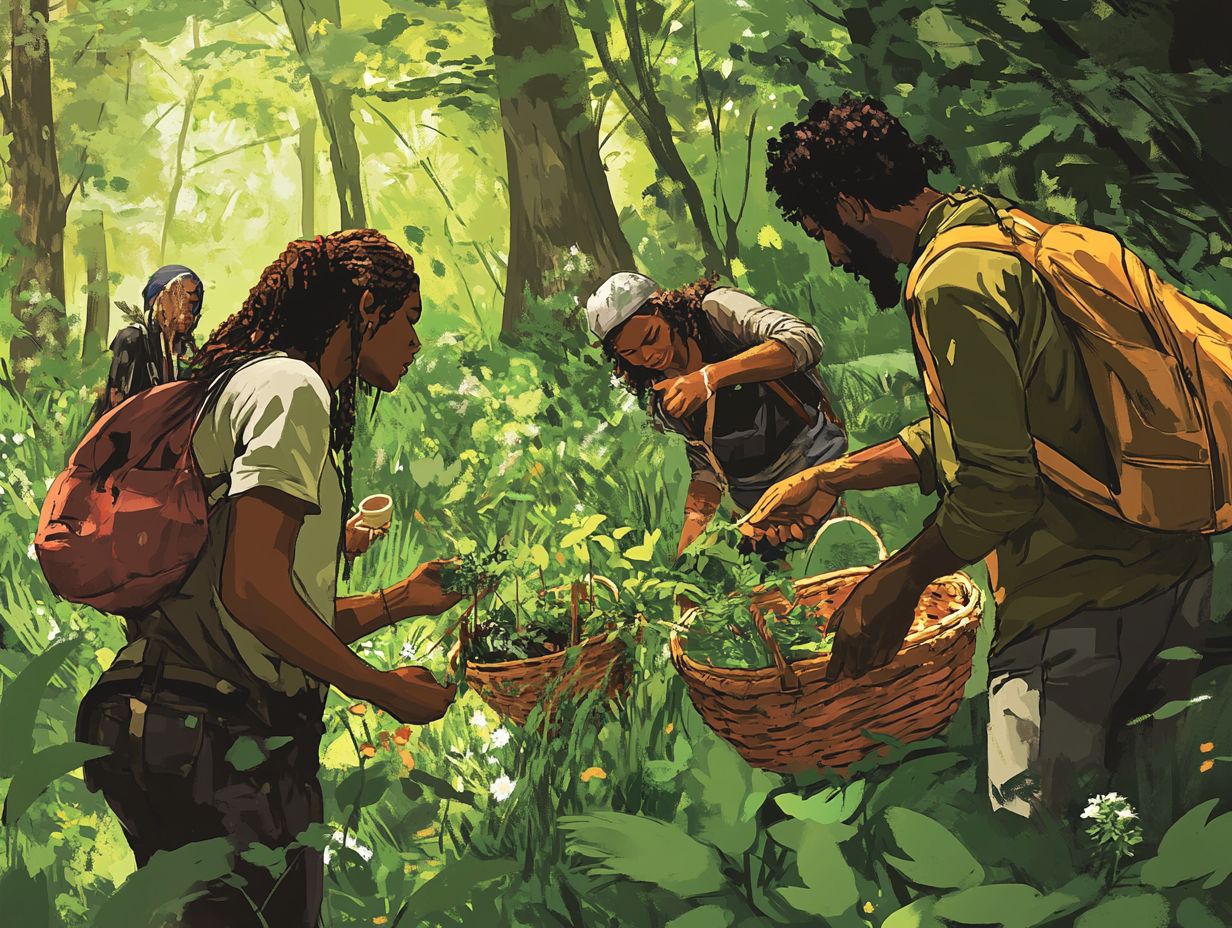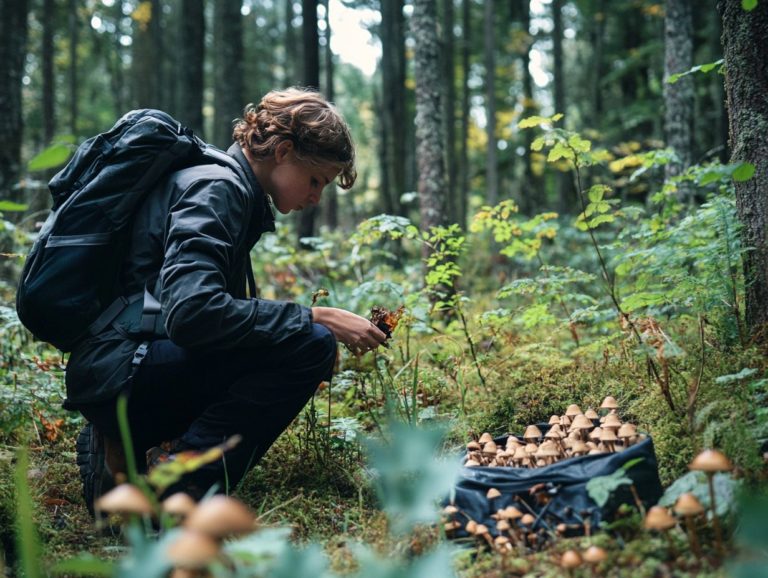How to Organize a Community Foraging Event?
Community foraging is a delightful and enriching practice that invites you to explore local ecosystems while gathering edible plants and mushrooms. Get ready to enhance your connection with nature and build friendships!
This activity fosters social bonds and promotes environmental stewardship.
Discover how to organize your own foraging event, select the finest locations, and implement safe, sustainable practices. Prepare yourself to engage with both nature and your community in a truly meaningful way!
Contents
- Key Takeaways:
- What is Community Foraging?
- Benefits of Community Foraging
- How to Organize a Community Foraging Event
- Choosing the Right Location
- Ensuring Safety and Sustainability
- Engaging the Community
- Frequently Asked Questions
- What is a community foraging event?
- How do I start organizing a community foraging event?
- Do I need any special permits or permissions to hold a community foraging event?
- How can I promote my community foraging event?
- What should I bring to a community foraging event?
- Can anyone participate in a community foraging event?
Key Takeaways:

- Community foraging involves gathering wild food from shared spaces.
- It brings social, environmental, and economic benefits.
- Successful events require careful location choice and community engagement.
What is Community Foraging?
Community foraging is an enriching practice that invites you to join others in exploring your local ecosystems in pursuit of wild edible plants while gathering food ethically. This collaborative approach cultivates a sense of community and elevates your understanding of wild food, especially when you learn how to start a community garden with foraged edibles, allowing you to discover the diverse and nutritious plants that thrive in your surroundings.
In areas such as Victoria and the Pacific Northwest, community-supported foraging initiatives are becoming popular, fostering sustainable harvesting and enhancing food security. This experience allows you to forge a deeper connection with nature and indigenous cultures, enriching both your palate and your perspective.
Defining the Practice
Defining the practice of community foraging explores how it nurtures connections among individuals, nature, and the culinary potential of wild plants through shared knowledge and ethical foraging principles.
This approach enhances your awareness of the edible plants thriving in local ecosystems while underscoring the importance of ethical sourcing practices that honor both the environment and its seasonal rhythms. Participate in guided foraging excursions to learn how to identify and harvest wild foods responsibly.
Urban parks provide accessible spaces for gardening and cultivating edible plants. These green hubs bolster food security in urban settings and promote sustainability by encouraging connections with food sources, fostering a deeper appreciation for biodiversity and the environment.
Benefits of Community Foraging
Community foraging offers a wealth of benefits across social, environmental, and economic dimensions. Engaging in this practice enhances local ecosystems and cultivates strong community bonds through shared experiences and knowledge of wild plants.
Social, Environmental, and Economic Benefits
The social benefits of community foraging encompass relationship-building and community activism. Its environmental advantages tackle critical issues such as invasive species management and the promotion of sustainable harvesting practices.
When you engage in community foraging, you re not just gathering food; you re forging meaningful connections with your neighbors. These shared experiences often inspire local workshops, where participants dive into the world of native plants, nurturing a deeper sense of belonging and shared responsibility.
This practice also invites you to take an active role in environmental stewardship. As a group, collaborate to identify and eradicate invasive species threatening the local ecosystem. Such initiatives enhance biodiversity and stimulate local economic development. Promote foraged goods at farmers’ markets or community events to showcase the rich natural resources unique to your area, turning a simple gathering into a celebration of nature’s bounty.
Join the movement! Start your foraging adventure today!
How to Organize a Community Foraging Event

Organizing a community foraging event calls for careful planning and thoughtful consideration of various factors. To create a rewarding experience that enhances wild food education and fosters ethical foraging practices within local ecosystems, it’s helpful to follow a guide on how to organize a local foraging event.
Step-by-Step Guide
The first step in planning your community foraging event is to identify your objectives and the local ecosystems you’ll explore. Additionally, consider referring to this guide on how to set up foraging community events to ensure that your chosen location boasts a diverse range of wild edible plants.
This initial phase is crucial as it lays the groundwork for an engaging and educational experience. Once you’ve pinpointed a suitable area, it’s time to establish clear goals. Whether that’s promoting sustainability, enhancing knowledge of local flora, or building community connections.
To create a truly enriching atmosphere, consider collaborating with local experts in foraging practices. This will ensure that participants learn about ethical harvesting methods, which means taking only what you need and leaving enough for wildlife and future growth.
Following this, you’ll want to engage community members and stakeholders through social media, flyers, or local gatherings.
By connecting with local groups and environmental organizations, you’re not just raising awareness you re also gathering invaluable feedback that can enhance the event’s relevance and enjoyment.
Choosing the Right Location
Selecting the ideal location for a community foraging event is essential. It influences the accessibility of wild plants, the safety of the surroundings, and supports the objectives of promoting ethical foraging in your community while enhancing community engagement.
Factors to Consider
When choosing a location for foraging, several key factors come into play. Consider the types of wild plants available, safety concerns, and environmental aspects that may influence your overall experience.
As a foraging enthusiast, it’s crucial to invest time in researching the various edible plants that flourish in your intended area. This knowledge is essential for correctly identifying which species are safe for consumption.
Be vigilant about safety risks, such as potential contamination from pollutants or the proximity to livestock, which can pose significant health hazards.
Understanding local regulations is vital. Familiarizing yourself with guidelines like the BC Weed Control Act will help you navigate the legal landscape responsibly. This ensures that you harvest in a sustainable and responsible manner while respecting native ecosystems.
Each of these elements enhances your foraging journey. They allow you to cultivate a deeper appreciation for nature and all it has to offer.
Ensuring Safety and Sustainability
Ensuring safety and sustainability in community foraging is essential for protecting both participants and local ecosystems. By promoting ethical foraging practices, you can respect the environment while supporting sustainable harvesting. This creates a harmonious balance between enjoying nature’s bounty and preserving it for future generations.
Tips for Responsible Foraging

Tips for responsible foraging emphasize the importance of ethical practices, sustainability, and wild food education. Get ready to enjoy the wild plants while ensuring their habitats are preserved.
Understanding how to identify wild edibles, such as elderberry and nettles, is essential. These plants not only add to your culinary repertoire but also come packed with health benefits.
It s vital to educate yourself on the specific characteristics of each species, so you can distinguish them safely and accurately.
When you practice wildcrafting responsibly, remember to take only what you need, leaving plenty for wildlife and future growth. This approach helps maintain ecological balance. By being mindful of your environment and the impact of your activities, you have the chance to make a big difference!
Join us in discovering the wonders of foraging and make your mark on local ecology!
Engaging the Community
Engaging the community is crucial for the success of foraging events. It fosters participation, enriches wild food education, and strengthens community ties through shared experiences. For those interested in organizing, consider these tips for starting your own foraging group to promote collective activism focused on local food systems.
Promoting and Encouraging Participation
Promoting participation in community foraging requires effective outreach. Use social media to raise awareness and spark interest in local ecosystems, and consider sharing tips on how to prepare for a foraging outing.
Collaborate with local influencers who share a passion for nature and sustainability. This helps you reach established audiences that resonate with your mission.
Craft visually appealing and informative content for platforms like Instagram and Facebook. This can spark engagement and stimulate lively conversations around foraging practices.
Distributing flyers in community centers, cafes, and libraries, along with posting on community boards, ensures that your initiative reaches a diverse audience. Using various methods helps spread your message far and wide!
This approach cultivates a sense of community ownership. As a result, individuals are more inclined to participate in foraging and develop a deeper appreciation for the natural resources surrounding them.
Frequently Asked Questions
What is a community foraging event?
A community foraging event is a gathering where members of a community come together to gather and harvest food from local sources, such as wild plants, fruits, and nuts. If you’re interested in organizing one, consider checking out how to plan a foraging trip for helpful tips.
How do I start organizing a community foraging event?

The first step is to identify a suitable location for the event, such as a community park or nature reserve. Next, reach out to potential participants and gather volunteers to help with planning and logistics.
Do I need any special permits or permissions to hold a community foraging event?
It’s important to check with your local government or land management agencies to see if any permits or permissions are required for the gathering and harvesting of wild foods in the chosen location.
How can I promote my community foraging event?
Utilize social media, local community boards, and word of mouth to spread the word about the event. You can also reach out to local news sources and community organizations to help promote the event.
What should I bring to a community foraging event?
It’s recommended to bring a basket or bag for collecting food, gardening gloves, and a small knife for harvesting. It’s also a good idea to bring some water and a light snack.
Can anyone participate in a community foraging event?
Yes, community foraging events are open to anyone interested in learning about wild foods and participating in a communal gathering. If you’re looking to find these events, you can check out how to use Meetup for local foraging events. However, it’s always important to respect the rules and regulations of the designated location and to forage responsibly.
Join us for an unforgettable adventure in foraging! Sign up now!






